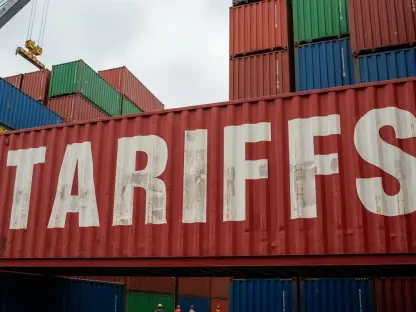Today, we’re thrilled to sit down with Rohit Laila, a seasoned expert in the logistics industry with decades of experience in supply chain and delivery. His deep understanding of international trade dynamics, paired with a passion for technology and innovation, makes him the perfect person to unpack the recent developments in U.S.-Canada trade relations. We’ll dive into the complexities of President Trump’s announcement of a 10% tariff hike on Canadian imports, the backdrop of existing trade tensions, the impact of a controversial anti-tariff ad by the Government of Ontario, and the broader implications for industries and negotiations between the two nations.
Can you walk us through the significance of President Trump announcing a 10% tariff increase on Canadian imports through a social media platform like TruthSocial?
Certainly. Announcing a policy shift like this on social media, rather than through traditional channels, is a bold move. It bypasses the usual filters of press conferences or official statements, allowing for a direct, unscripted message to the public. However, it can also create uncertainty since platforms like TruthSocial don’t provide the space for detailed context or timelines. This approach often amplifies immediate reactions—both positive and negative—and in this case, it seems designed to grab attention quickly, especially amid ongoing trade tensions with Canada. It signals urgency but risks being perceived as less formal or even impulsive by stakeholders in logistics and trade who rely on clarity.
How do you think the choice of social media over a formal announcement shapes public and industry perceptions of this tariff decision?
It’s a double-edged sword. On one hand, it makes the announcement accessible and relatable to a broader audience, cutting through bureaucratic red tape. On the other hand, industries like logistics, where I’ve spent my career, crave predictability. A social media post lacks the depth we need—there’s no mention of timelines or specific goods targeted. This can rattle markets and supply chains, as businesses are left guessing about compliance and costs. Public perception might lean toward seeing this as a personal or political statement rather than a calculated economic policy, which could undermine confidence in the decision-making process.
What’s your take on the potential timeline for rolling out these new tariffs on Canadian goods?
Unfortunately, there’s little concrete information to go on right now. The announcement via TruthSocial didn’t specify when these tariffs would take effect, which is frustrating for those of us in logistics. Based on past patterns, such as the 35% tariffs imposed since August 1, we might expect an expedited rollout to maintain pressure in trade negotiations. However, without official guidance, it’s speculative. I’d wager we’re looking at weeks rather than months, as delays could dilute the intended impact. Companies in affected sectors are likely already bracing for near-term disruptions.
Are there particular industries or products you suspect might feel the brunt of this tariff increase first?
Given the existing sector-specific tariffs on autos, lumber, and steel, I’d expect those industries to remain in the crosshairs. They’re already navigating a 35% levy, so an additional 10% could compound challenges, especially for supply chains that are tightly integrated across the U.S.-Canada border. Beyond that, consumer goods or agricultural products could also be targeted if the goal is to maximize economic pressure. These sectors often have fewer exemptions under agreements like the United States-Mexico-Canada Agreement, making them vulnerable. Logistics firms like mine are already mapping out contingency plans for rerouting or cost absorption in these areas.
How do the existing 35% tariffs on Canadian imports factor into the impact of this new 10% increase?
The 35% tariffs, in place since August 1, have already strained cross-border trade significantly. They’ve forced many companies to either absorb higher costs or pass them on to consumers, which impacts competitiveness. Adding another 10% on top creates a cumulative burden—now we’re talking about a potential 45% levy on many goods. This isn’t just incremental; it’s exponential in terms of logistical complexity and cost. Some relief exists through exemptions under the United States-Mexico-Canada Agreement, but not all goods qualify, and navigating those rules is a headache for businesses. It’s a tough environment for industries reliant on seamless trade.
Can you shed light on the anti-tariff TV ad by the Government of Ontario that seems to have sparked this tariff escalation?
Absolutely. The ad, aired in the U.S., was a bold countermove by Ontario to sway public and political opinion against tariffs. It cleverly used excerpts from a 1987 speech by Ronald Reagan, where he highlighted the downsides of duties and championed free trade. The choice of Reagan—a revered figure in American politics—was likely meant to resonate emotionally with U.S. audiences and policymakers, framing tariffs as contrary to historical Republican values. From a logistics perspective, it’s fascinating because it shows how trade disputes are no longer just about numbers; they’re about narrative and perception. But clearly, it hit a nerve with the current administration.
How did the reaction from the Ronald Reagan Presidential Foundation and Institute play into the broader trade conflict?
The Foundation’s response was swift and critical, publicly denouncing the unauthorized use of Reagan’s speech via a statement on X. Their primary concern was that repurposing the speech for a current political agenda misrepresented Reagan’s intent, as his 1987 comments were tied to temporary tariffs on Japan, not a blanket stance on trade policy. This reaction gave President Trump ammunition to frame the ad as not just provocative but disrespectful, amplifying his decision to terminate trade negotiations. It turned a policy disagreement into a cultural and symbolic flashpoint, which complicates the path to resolution.
What can you tell us about President Trump’s response to the Ontario ad and its immediate effect on U.S.-Canada trade talks?
Trump’s reaction was visceral. He reshared the Foundation’s statement on TruthSocial and accused the ad of being an attempt to meddle with a Supreme Court tariff decision—an assertion that’s raised eyebrows since the connection isn’t entirely clear. His declaration to terminate all trade negotiations with Canada was a dramatic escalation, signaling a complete breakdown in dialogue, at least for now. From my vantage point in logistics, this kind of rhetoric disrupts planning—businesses rely on stable talks to forecast costs and routes. The immediacy of his statement suggests this was more about sending a message than a permanent policy shift, but it’s still a major hurdle.
How have Canadian leaders responded to this latest tariff announcement and the suspension of trade negotiations?
Canadian leadership has tried to strike a balanced tone. Prime Minister Mark Carney emphasized that significant progress had been made in trade discussions prior to this fallout, expressing readiness to resume talks whenever the U.S. is willing. It’s a diplomatic stance, aiming to keep the door open. Meanwhile, Ontario Premier Doug Ford, after discussions with Carney, opted to pause the ad campaign starting Monday—though notably, the ads still aired during World Series games in Toronto over the weekend. This suggests a pragmatic retreat to de-escalate while still maximizing exposure of their message. It’s a delicate dance, reflecting Canada’s dependence on U.S. trade.
Looking ahead, what is your forecast for the future of U.S.-Canada trade relations given these recent developments?
I’m cautiously pessimistic in the short term. The combination of escalating tariffs, halted negotiations, and public spats over messaging like the Ontario ad points to a rocky road ahead. Logistics and supply chain sectors will bear the immediate costs—delays, higher expenses, and uncertainty are almost guaranteed. However, the deep economic integration between the U.S. and Canada, underpinned by agreements like the USMCA, means neither side can afford a prolonged standoff. I expect backchannel efforts to resume talks within months, but much depends on political will and whether both sides can move past symbolic grievances to focus on mutual economic benefits. We in the industry are hoping for a pragmatic resolution, but we’re preparing for turbulence in the meantime.









